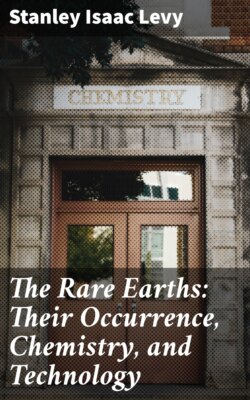Читать книгу The Rare Earths: Their Occurrence, Chemistry, and Technology - Stanley Isaac Levy - Страница 168
На сайте Литреса книга снята с продажи.
(c) Complex Silicates Eudialyte (Eucolyte).
Оглавление—This is a complex silicate of alkalies, lime, ferrous oxide, rare earths, etc., containing chlorine and a high proportion (up to 17 per cent.) of zirconia. The empirical formula is given by Dana as Na₁₃(Ca,Fe)₆Cl(Si,Zr)₂₀O₅₂. Brögger gives the simpler metasilicate formula R´₄R´´₃Zr(SiO₃)₇, where R = (Na,K,H), R´´ = (Ca,Fe,Mn,CeOH), and Zr(OCl) may partly function as an acid in place of SiO₂. The true formula, however, is quite uncertain, as the zirconia may function either as an acidic or basic oxide. The fact that a mineral of such exceedingly complex composition occurs in perfectly well-defined crystals indicates the intricate nature of the problems to be solved in mineral chemistry.
The crystals are rhombohedral, a: c = 1: 2·1116.
Common forms are—the pinakoid c {111}, prisms a {101}, and m {211}, and pyramids r {100} and e {110}. c ∧ r = 31° 22´. Habit tabular parallel to c, rhombohedral with e prominent, or prismatic with a prominent.
Cleavage ∥ c very good, ∥ a difficult.
The colour is brown or red to brownish- or bluish-red. Brittle. Hardness 5 to 51⁄2; sp. gr. 2·92 for eudialyte, 3·0 to 3·1 for eucolyte.
The double refraction is strong, being positive for eudialyte, negative for the Norwegian variety, eucolyte. From careful microscopic examination, Ramsay has found that zones of positive and negative birefringence, as well as isotropic (singly-refracting) zones can occur on the same crystal, and he suggests that the mineral is really composed of two isomorphous compounds forming mixtures. In view of the continuous variation of optical properties in an isomorphous series like the felspars, such an explanation seems doubtful. The optical behaviour of minerals is very often anomalous, and the phenomena in this case are probably due to repeated twinning, with some alteration in the double refraction, or to the lamellar intergrowth of two varieties having slightly different optical properties.
On heating, the mineral evolves moisture and readily fuses. It is easily attacked even by dilute acids, being named by Strohmeyer (1819) on account of this property. The dilute hydrochloric acid solution reddens turmeric paper—a test for the presence of zirconium.
It is found in Greenland, usually embedded in felspar, in Norway, in Lapland and in Arkansas, being generally associated with minerals rich in alkalies, e.g. ægirine, ælæolite, nepheline, sodalite, arfvedsonite, etc.
